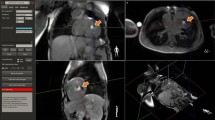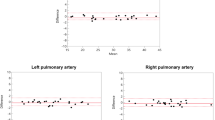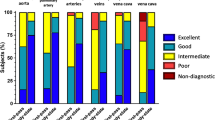Abstract
To describe a novel time-resolved magnetic resonance angiography (TR-MRA) postprocessing technique using the time-resolved angiography with interleaved stochastic trajectories (TWIST) method to evaluate the pulmonary veins and left atrium in adults with congenital heart disease undergoing cardiac MRI. Institutional ethics committee approved the study. 21 consecutive adult patients (14 female, 7 male patients, mean age 28 years) with known congenital heart disease who underwent a cardiac MRI were included. Post-processing of the TR-MRA sequences created novel “subtracted” datasets. Two independent observers reviewed the conventional TWIST and novel subtracted TWIST data sets in source and maximum intensity projection (MIP) coronal reformats to assess visualization of the pulmonary veins and left atrium based on a 5-point scale. Quantitative signal to noise (SNR) comparison was performed. TR-MRA yielded diagnostic image data in 20/21 patients (95.2%). The novel “subtracted” TR-MRA technique improved visualization of the pulmonary veins and left atrium compared to the source TR-MRA sequence in 16/20 patients (mean scores 3.34 ± 0.69 vs. 2.92 ± 0.69, p < 0.008). Further improved visualization of the pulmonary veins and left atrium was observed in the subtracted MIP TWIST sequences compared to the MIP TWIST images (mean scores 4.43 ± 0.80 vs. 3.02 ± 0.87 vs., p < 0.001). No significant SNR difference between the source and novel subtracted group was observed (85.4 vs. 70.4, p = 0.57). Compared to source TR-MRA images, subtraction of TR-MRA images is a novel postprocessing technique that improves visualization of the pulmonary veins and left atrium in a substantial number of patients.



Similar content being viewed by others
Abbreviations
- MRI:
-
Magnetic resonance imaging
- CHD:
-
Congenital heart disease
- MRA:
-
Magnetic resonance angiography
- TWIST:
-
Time-resolved angiography with interleaved stochastic trajectories
- RSPV:
-
Right superior pulmonary vein
- LA:
-
Left atrium
- ROI:
-
Region of interest
- PA:
-
Pulmonary artery
- MIP:
-
Maximum intensity projection
- SI:
-
Signal intensity
- SNR:
-
Signal-to-noise
- TR-MRA:
-
Time resolved magnetic resonance angiography
- CE-MRI:
-
Contrast enhanced magnetic resonance angiography
References
Foster E, Graham TP Jr, Driscoll DJ et al (2001) Task force 2: special health care needs of adults with congenital heart disease. J Am Coll Cardiol 37:1176–1183
Lane DA, Lip GY, Millane TA (2002) Quality of life in adults with congenital heart disease. Heart 88:71–75
Fenchel M, Saleh R, Dinh et al (2007) Juvenile and adult congenital heart disease: time-resolved 3D contrast-enhanced MR angiography. Radiology 244:399–410
Vogt FM, Theysohn JM, Michna D et al (2013) Contrast-enhanced time-resolved 4D MRA of congenital heart and vessel anomalies: image quality and diagnostic value compared with 3D MRA. Eur Radiol 23:2392–2404
Schonberger M, Usman A, Galizia M et al (2013) Time-resolved MR venography of the pulmonary veins precatheter-based ablation for atrial fibrillation. J Magn Reson Imaging 37:127–137
Zghaib T, Shahid A, Pozzessere C et al (2018) Validation of contrast-enhanced time-resolved magnetic resonance angiography in pre-ablation planning in patients with atrial fibrillation: comparison with traditional technique. Int J Cardiovasc Imaging 16:1–8
Song T, Laine AF, Chen Q et al (2009) Optimal k-Space sampling for dynamic contrast-enhanced MRI with an application to MR renography. Magn Resonan Med 61:1242–1248
Finn JP, Baskaran V, Carr JC et al (2002) Thorax: low-dose contrast-enhanced three-dimensional MR angiography with subsecond temporal resolution—initial results. Radiology 224:896–904
Van Hoe L, De Jaegere T, Bosmans H et al (2000) Breath-hold contrast-enhanced three-dimensional MR angiography of the abdomen: time-resolved imaging versus single-phase imaging. Radiology 214:149–156
Swan JS, Carroll TJ, Kennell TW (2002) Time-resolved three-dimensional contrastenhanced MR angiography of the peripheral vessels. Radiology 225:43–52
Driessen MM, Breur JM, Budde RP et al (2015) Advances in cardiac magnetic resonance imaging of congenital heart disease. Pediatric Radiol 45(1):5–19
Tsao J, Kozerke S (2012) MRI temporal acceleration techniques. J Magn Reson Imaging 36:543–560
Riederer SJ, Tasciyan T, Farzaneh F et al (1988) MR fluoroscopy: technical feasibility. Magn Reson Med 8:1–15
van Vaals JJ, Brummer ME, Dixon WT et al (1993) ‘‘Keyhole’’ method for accelerating imaging of contrast agent uptake. J Magn Reson Imaging 3:671–675
Korosec FR, Frayne R, Grist TM et al (1996) Time-resolved contrast-enhanced 3D MR angiography. Magn Reson Med 36:345–351
Fink C, Ley S, Kroeker R et al (2005) Time-resolved contrast-enhanced three-dimensional magnetic resonance angiography of the chest: combination of parallel imaging with view sharing (TREAT). Invest Radiol 40:40–48
Doyle M, Walsh EG, Blackwell GG et al (1995) Block regional interpolation scheme for k-space (BRISK): a rapid cardiac imaging technique. Magn Reson Med 33:163–170
Parrish T, Hu X (1995) Continuous update with random encoding (CURE): a new strategy for dynamic imaging. Magn Reson Med 33:326–336
Rapacchi S, Natsuaki Y, Plotnik A (2015) Reducing view-sharing using compressed sensing in time-resolved contrast-enhanced magnetic resonance angiography. Magn Reson Med 74:474–481
Hinton DP, Wald LL, Pitts J et al (2003) Comparison of cardiac MRI on 1.5 and 3.0 T clinical whole body systems. Invest Radiol 38:436–442
Prompona M, Muehling O, Naebauer M et al (2011) MRI for detection of anomalous pulmonary venous drainage in patients with sinus venosus atrial septal defects. Int J Cardiovasc Imaging 27:403–412
Ferrari VA, Scott CH, Holland GA et al (2001) Ultrafast three-dimensional contrast-enhanced magnetic resonance angiography and imaging in the diagnosis of partial anomalous pulmonary venous drainage. J Am Coll Cardiol 37:1120–1128
Festa P, Ait-Ali L, Cerillo AG et al (2006) Magnetic resonance imaging is the diagnostic tool of choice in the preoperative evaluation of patients with partial anomalous pulmonary venous return. Int J Cardiovasc Imaging 22:685–693
Deshmukh A, Patel NJ, Pant S et al (2013) In-hospital complications associated with catheter ablation of atrial fibrillation in the United States between 2000 and 2010: analysis of 93 801 procedures. Circulation 128:2104–2112
Kistler PM, Rajappan K, Jahngir M et al (2006) The impact of CT image integration into an electroanatomic mapping system on clinical outcomes of catheter ablation of atrial fibrillation. J Cardiovasc Electrophysiol 17:1093–1101
Ghaye B, Szapiro D, Dacher JN, Rodriguez et al (2003) Percutaneous ablation for atrial fibrillation: the role of cross-sectional imaging. Radiographics 23(suppl_1):S19–S33
Author information
Authors and Affiliations
Corresponding author
Ethics declarations
Conflict of interest
The authors declared that they have no conflict of interest.
Additional information
Publisher’s Note
Springer Nature remains neutral with regard to jurisdictional claims in published maps and institutional affiliations.
Electronic supplementary material
Below is the link to the electronic supplementary material.
Supplementary material 1 (MP4 614 KB)
Supplementary material 2 (MP4 541 KB)
Rights and permissions
About this article
Cite this article
Sugrue, G., Cradock, A., McGee, A. et al. Subtraction of time-resolved magnetic resonance angiography images improves visualization of the pulmonary veins and left atrium in adults with congenital heart disease: a novel post-processing technique. Int J Cardiovasc Imaging 35, 1339–1346 (2019). https://doi.org/10.1007/s10554-019-01585-x
Received:
Accepted:
Published:
Issue Date:
DOI: https://doi.org/10.1007/s10554-019-01585-x




